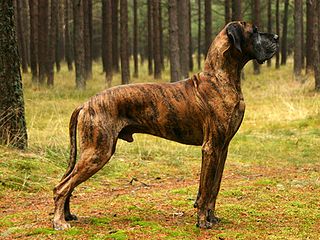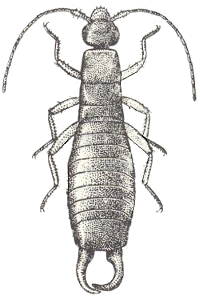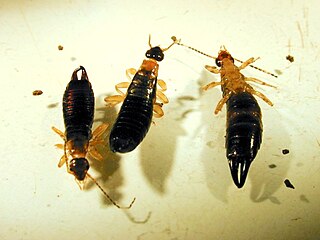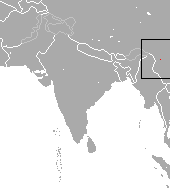
The Boxer is a medium to large, short-haired dog breed of mastiff-type, developed in Germany. The coat is smooth and tight-fitting; colors are fawn, brindled, or white, with or without white markings. Boxers are brachycephalic, have a square muzzle, mandibular prognathism, very strong jaws, and a powerful bite ideal for hanging on to large prey. The Boxer was bred from the Old English Bulldog and the now extinct Bullenbeisser, which became extinct by crossbreeding rather than by a decadence of the breed. The Boxer is a member of both The Kennel Club and American Kennel Club (AKC) Working Group.

The Integrated Taxonomic Information System (ITIS) is an American partnership of federal agencies designed to provide consistent and reliable information on the taxonomy of biological species. ITIS was originally formed in 1996 as an interagency group within the US federal government, involving several US federal agencies, and has now become an international body, with Canadian and Mexican government agencies participating. The database draws from a large community of taxonomic experts. Primary content staff are housed at the Smithsonian National Museum of Natural History and IT services are provided by a US Geological Survey facility in Denver. The primary focus of ITIS is North American species, but many biological groups exist worldwide and ITIS collaborates with other agencies to increase its global coverage.

The Cardigan Welsh corgi is one of two different varieties of livestock-herding dog breeds known as Welsh corgis, with the other being the Pembroke Welsh corgi. It is one of the oldest breeds of the British Isles. Cardigan Welsh corgis are known to be an extremely loyal and trainable dog breed, naturally attuned to herding many different animals, from poultry and waterfowl to large livestock such as sheep and cattle. They are also versatile and can live in a variety of settings.

Brindle is a coat coloring pattern in animals, particularly dogs, cattle, guinea pigs, cats, and, rarely, horses. It is sometimes described as "tiger-striped", although the brindle pattern is more subtle than that of a tiger's coat.

Anisolabis is a genus of mostly Asian earwigs in the subfamily Anisolabidinae. It was cited by Srivastava in Part 2 of Fauna of India. The name Anisolabis stems from the asymmetry of the male cerci; the right cercus being more acute than the left.

Euborellia is a genus of earwigs in the subfamily Anisolabidinae. This genus, which has a world-wide distribution, was erected by Malcolm Burr in 1909 and was cited by Srivastava in Part 2 of Fauna of India.

Chelisochidae is a family of earwigs whose members are commonly known as black earwigs. The family contains a total of approximately 96 species, spread across sixteen genera in three subfamilies.
Anisolabis hawaiiensis is a species of earwig in the genus Anisolabis, the family Anisolabididae, and the order Dermaptera. The species is native to Hawaii, and was first classified by Brindle in 1979.
Anisolabis howarthi is a blind, troglobite species of earwig in the genus Anisolabis, the family Anisolabididae, and the order Dermaptera. The species is native to Hawaii, and was first classified by Brindle in 1979. According to a paper published by him in 1980 in the journal Pacific Insects, the species is first known true troglobite earwig; while there are other blind species that live underneath soil or humus, this is the first to actually inhabit a cave.

The seashore earwig is a species of earwig in the family Anisolabididae. The species was first described in 1846 by Adam White. This species has a blackish-brown body with brown-yellow legs. It has two light brown spots on its head, close to the inside of each eye. Its abdomen is widest at the seventh segment. It is flightless. It is native to eastern Australia and New Zealand. Similar both ecologically and taxonomically to the maritime earwig, this species is commonly found on beaches under stones and debris. It is a carnivore, feeding on millipedes, flies, and isopods such as woodlice. Like most other earwigs, the females care for their young during development, and the larva go through five instars before becoming adults. The species also has a negative phototaxis, meaning that it tends to move away from a light source.

Anisolabis maritima, commonly known as the maritime earwig or the seaside earwig, is a species of earwig in the family Anisolabididae. Similar to the seashore earwig, this species can be found near the shore line, and is cosmopolitan. It can be found in almost all biogeographic realms. Scientists believe that these earwigs originally came from Asia. Since then, however, they have been introduced to North America, and have now spread around the world due to international commerce.
Anisolabis mauiensis is a species of earwig in the genus Anisolabis, the family Anisolabididae, and the order Dermaptera.
The Pacific earwig is a species of earwig in the genus Anisolabis, the family Anisolabididae and the order Dermaptera.

Doru is a genus of earwigs in the family Forficulidae.
Aagaardia is a genus of fly in the Chironomidae family. Aagaardia has been found in Finland, the mainland of Norway and Russia.

Van Sung's shrew, also known as Cao Van Sung mountain shrew is a species of shrew in the Soricomorpha order. Specimens of Chodsigoa caovansunga have been found in Vietnam.

The pygmy brown-toothed shrew is a species of shrew in the order Eulipotyphla. It is distributed in China. C. parva was initially thought to be the same as Chodsigoa lamula, but it was found to be a separate species.

The lesser Taiwanese shrew is a rare species of shrew in the Soricomorpha order.











